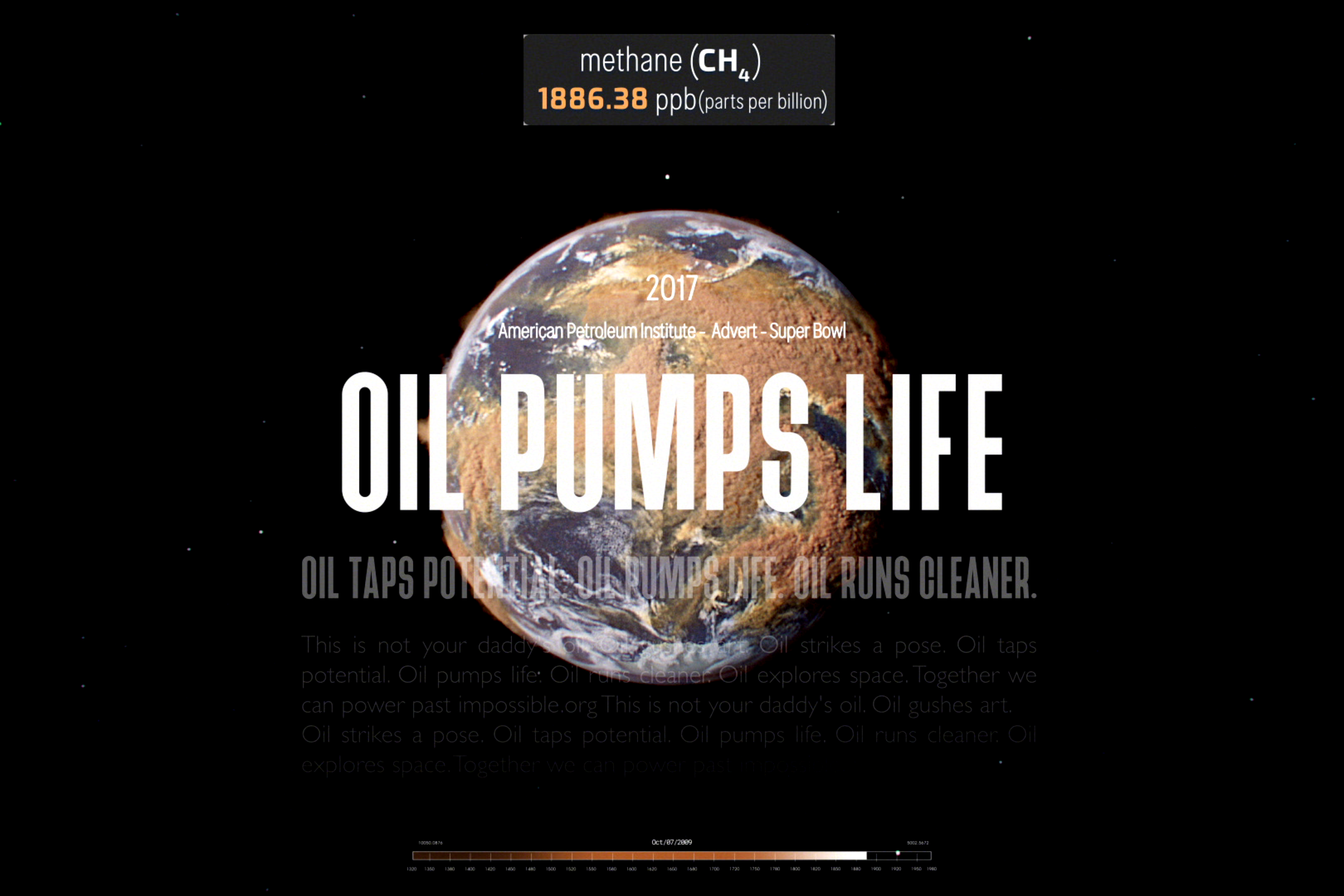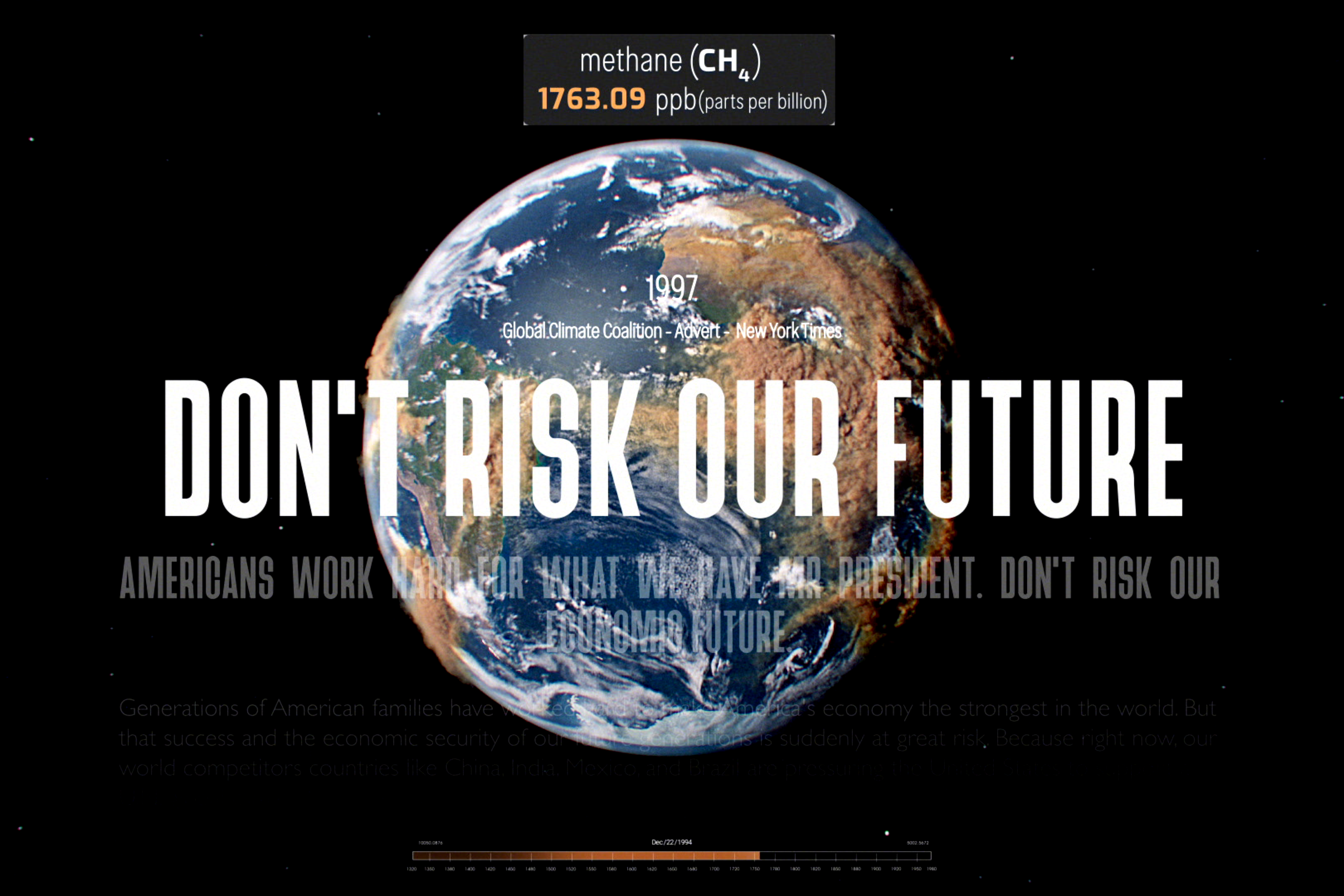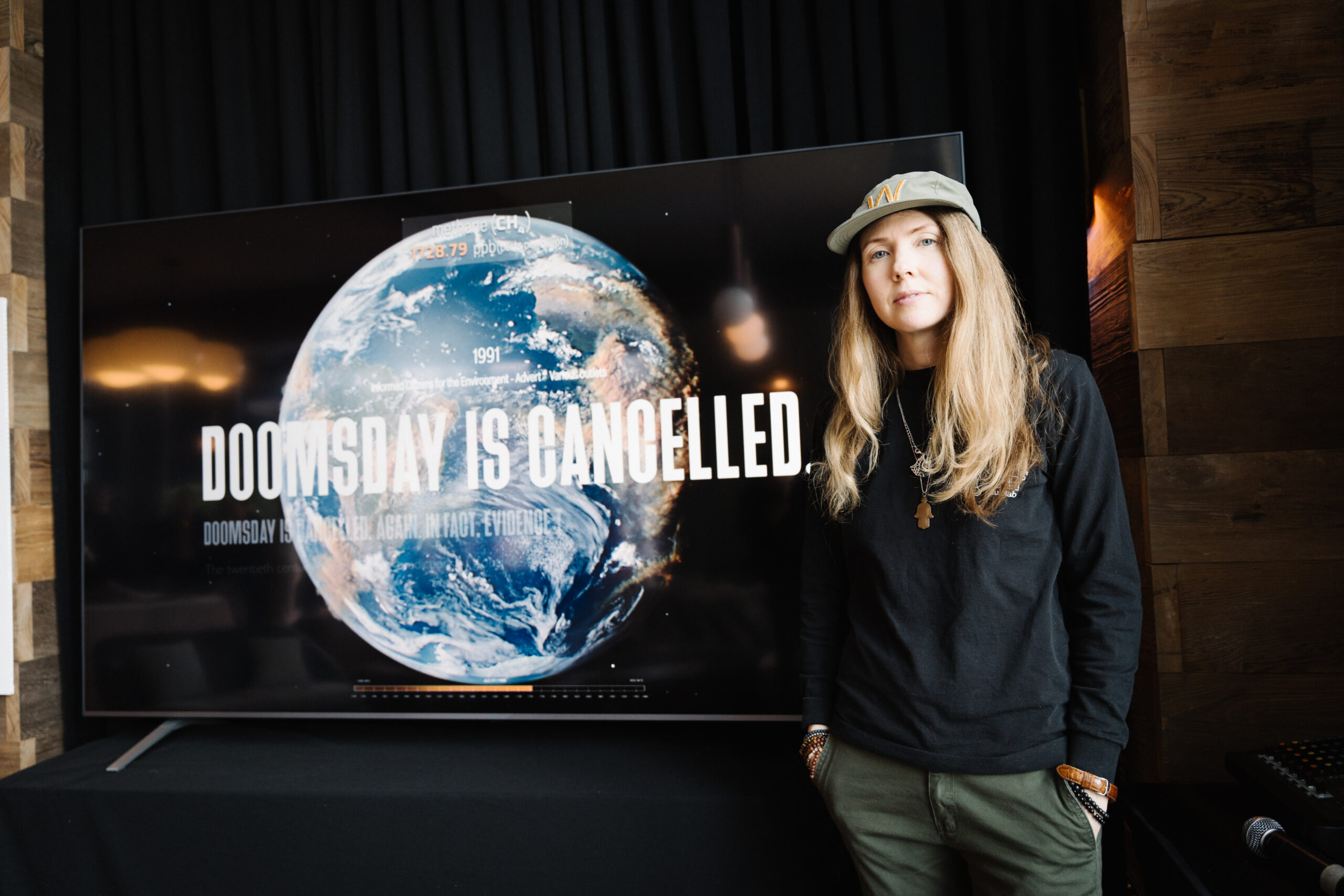“Smoke and Mirrors” by British artist Beatie Wolfe visualises 50 years of climate data and contrasts it with advertising slogans from the oil industry. She has now been awarded the Golden Nica of the Prix Ars Electronica for her work.
Wolfe’s project, which earned her the Golden Nica in the ‘New Animation Art’ category, uses art to illustrate the rise in methane levels over the past five decades. The striking visualization, created in collaboration with Parliament, an independent visual effects and creative studio, and based on NASA’s Blue Marble photographs, contrasts this data with oil industry advertising slogans designed to undermine awareness of climate change. The project is accompanied by the song ‘Oh my Heart,’ the first bioplastic record to be released. In an interview with Beatie Wolfe, we learned more about the process and realization of her project.
“What inspired you to create “Smoke and Mirrors”?
Beatie Wolfe: I had the idea for ‘Smoke and Mirrors’ in 2021 after my CO2 project “From Green to Red” came out and I saw how it helped people to see the climate data differently and to absorb it via the power of art. Realizing that a crucial piece of the climate puzzle (how we got to this critical point) has been the fossil fuel industry’s response to the emerging environmental awareness of the 1970s, and that methane emissions (30 times more potent than carbon for trapping heat) are increasingly linked with that industry, I felt compelled to illuminate this key parallel timeline. While “From Green to Red” visualized 800,000 years of rising CO2 levels, “Smoke and Mirrors” focuses on just fifty years of methane data set alongside the Big Oil advertising campaigns that were running during this critical period in human history.

Can you describe the creative process behind “Smoke and Mirrors”?
Beatie Wolfe: After I had the initial idea for the piece there were a few alternate versions rotating around in my mind, as there often are with a project. As I had just finished “From Green to Red” (presented as a video, an interactive museum installation and a projection piece) I was at first imagining the interactive version of Smoke and Mirrors… where you could trigger the climate data with one hand while the other hand activated the associated big oil spin. But I feel that with any project the core form and experience have to be as clear and integrated as possible before adding additional layers or modes of presentation. So that was a question of cohesively bringing together three elements: fossil fuel disinformation, methane data, and a powerful visual component that simultaneously illuminated this invisible killer, the dramatic increase in its level (especially in the last 50 years) as well as the little-known advertising campaigns which have sought to undermine this reality.
The process involved compiling a lot of research (both the big oil campaigns and methane data), building out the timeline for the piece and then setting the visualization in the most impactful world to communicate these sets of information, a world that really hit home. So, the iconic and deeply embedded NASA Blue Marble photograph felt like the perfect framing, with the Smoke and Mirrors timeline starting from 1970 and running until present day as the data, Blue Marble photograph, and even our first “Earth Day” all lined up with this. Then it was a question of working with the brilliant team at Parliament to get the right look, feel and expression for the visualization.

Were there any challenges in the implementation of the project – especially regarding the visualization of the climate data?
Beatie Wolfe: The main challenge was finding a way to present a lot of complex information in a digestible and immediate format. As Smoke and Mirrors both visualizes atmospheric methane concentration alongside a deeply rooted and concurrent disinformation campaign it required a lot of thought to find the right balance of accurately representing the data, elucidating the big oil playbook, while also making the piece evocative and relatable, all in 4m30s. It is very important to me that anyone can see the work and immediately get a sense of what they’re viewing, what is being communicated, whether they know anything about the topic or not. I want every project that I do to be inclusive and accessible and, in this case, to make the complex simple. It also took time to figure out the best selection of advertising campaigns to show the full spectrum of tactics deployed which also spanned that period. There are many more campaigns that didn’t make the final video but that are worth viewing which you can see on the project website.
The project is accompanied by the song “Oh My Heart”. Can you tell us more about the role of music in your project?
Beatie Wolfe: Like “From Green to Red” which was set to the song I wrote as a teenager after seeing An Inconvenient Truth, this visualization is set to a similarly interlinked and relevant track, “Oh My Heart,” which was released as the world’s first bioplastic record with Michael Stipe and Brian Eno’s EarthPecent. In both cases I feel that the music, lyrics etc. really help to bring the data and message to life, to make it feelable and relatable via art’s emotive power.
How has collaboration with scientists and other experts influenced and enriched your work?
Beatie Wolfe: Well, I couldn’t imagine my work without such collaborations, intersections, conversations; it would be impossible to pick it apart. I have always felt that all disciplines should be interwoven, as they used to be, and that it’s an odd thing to have separated everything into silos to begin with. So, for me it’s entirely natural for art and science to be in dialogue with one another, along with a number of other fields too. I think that we started to lose our way when we divided everything out into lanes and separated ourselves from nature simultaneously.

What are the goals of your project and what impact do you hope it will have on public awareness of climate change?
Beatie Wolfe: The ‘smoke and mirrors’ tactics of the big oil industry (and many political bodies and corporations) are so hard to grasp, which leaves a lot of people feeling disempowered, so I wanted this project to help make this slippery reality visible and tangible. Learning that the UN Secretary General recently said that ‘fossil fuel companies should be banned from advertising in every country,’ it would be wonderful if this project helped to contribute in any small way.
I hope that this project helps to illuminate a Truth that has been purposely obscured from view, one that has played and continues to play a major role in the critical climate emergency that we all face.
Beatie Wolfe

Beatie Wolfe
“Musical weirdo and visionary” (VICE magazine) has beamed her music into space, been appointed a UN role model for innovation, and held a solo exhibition of her ‘world first’ designs at the V&A Museum. Named by WIRED as one of “22 people changing the world,” Wolfe is at the forefront of pioneering new formats that bridge the physical and digital. Wolfe’s latest innovations include a visualization of 800,000 years of CO2 data, which premiered at the Nobel Prize Summit, and a Brain Installation which was exhibited at the London Design Biennale in Somerset House. Other recent projects include the world’s first bioplastic record with Michael Stipe and new work with Brian Eno. Wolfe is also the co-founder of a groundbreaking research project looking at the power of music for dementia.
